VIRTUAL DOJO
BASIC CONTACT DRILLS
The following photos are taken from old article of Mr. Heilman's from the mid 1990's. The article was published in both the States, Italy and Spain and dates back from Mr. Heilman's "Kyoshi" days. Mr. Heilman is assisted by IKKF Renshi Doug Hoover, at Mr. Hoover's Dojo in Martinsburg, Pa.
Body conditioning (tai gitae), forearm conditioning (kote kitae), and leg conditioning (ashi kitae) have long been an important part of traditional training in Okinawan Karate. This article presents a few simple training drills to help the student improve their forearm and leg conditioning and at the same time improve their blocking skills.
We have all read or heard the embellished stories of the ancient martial masters who performed feats of strength. These stories told by our instructors became the inspirations and legends to subsequent generations of martial artists pushing them to higher levels of training.
Body conditioning (tai gitae) has historically been an important aspect of martial arts practice in both China and Okinawa. Illustrations from old texts such as the Bubishi show rigorous conditioning routines being practiced by individuals to toughen up the fingertips, middle knuckles, forearms, legs, etc. It must be remembered that the original purpose for the development of the art of karate was for self-defense. Thus in any self-defense situation, survival is a key consideration. In order to increase ones odds of survival, it is only logical that the better conditioned our bodies are the better are chances of survival are as well. Of all of the styles of Okinawan karate, the systems of Goju-Ryu and Uechi-ryu tend to place the greatest emphasis on tai gitae.
Thus we see emphasis on strength development and endurance exercises in the practice of the Okinawan arts. These include the lifting or carrying of jars (kami) held by the fingertips as one moves through stances. Another device used for strengthening the wrist and forearm is called the chishi and are found in most Okinawan dojos. The chishi is typically made of stone or concrete with a handle. Another unique training device was the use of sashi. Sashi were stone locks used on ancient wooden gates. These were used for lifting and punching exercises.
One device known to just about everyone in the martial arts is the makiwara. The makiwara is a striking device with a padded surface used to practice contact punching, striking or kicking. Typical design of makiwara involves a shaft of wood firmly mounted in the floor with a padded surface, for striking at around the three to four foot height. However for makiwara training to be a benefit to the student, it is important that the makiwara placement be correct. Today one can easily purchase a "makiwara pads" from many martial arts suppliers. The problem here is that many individuals just mount this pad to a flat wall and begin to strike away - and end up with hand injuries. The correct design for a makiwara requires that the striking surface has "give".
It should also be recognized that one does not have to "deform" the hands by developing huge knuckles for the practice of makiwara training to have benefit. Through correct use of the makawara, the practitioner learns correct bone alignment for the punch or strike, toughens up the punching or striking surface and improves ones stance and balance.
KOTE KITAE:
Kote kitae or forearm conditioning is an important starting point to assist the practitioner to develop strong blocking techniques. There are a variety of these exercises which typically involve the systematic pounding of the forearms of training partners. The purpose of kote kitae is the toughening of the forearms which are heavily used for blocking in Okinawan karate.
Three areas of the forearm are the focus for this type of conditioning exercise. The areas which are used for blocking include: the inside of the forearm, outside of the forearm, and the back of the forearm. In the accompanying photos, the author takes the reader through a standard forearm conditioning drill. It is recommended that when employing these types of training exercises one should start slowly and work up your speed and power as you and your training partner improve. A far too often error made by beginners to conditioning exercises is to start out too strong and then wind up causing injury to themselves or their training partner. Just like stretching, this is not something that happens overnight - so give it time and work up to it slowly.
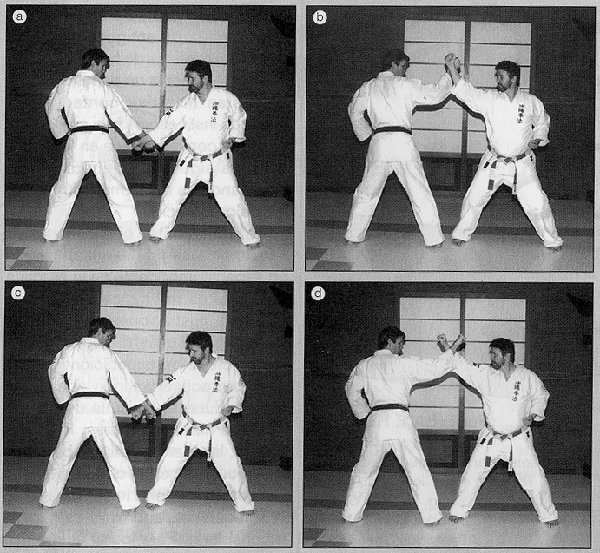
ASHI KITAE:
Ashi kitae or leg conditioning is an area of training which tends to be neglected by many modern practitioners. Uechi-ryu practitioners have however been known for their emphasis on leg conditioning.
The focus for the leg conditioning exercises are the outside and inside of the thighs. The hardening of the thighs is accomplished by repeatedly being kicked by a training partner, much in the same manner as with the forearm conditioning exercises. The shin of the kicking leg is employed as the striking surface and in this manner also provides conditioning to this body part.
A simple ashi kitae exercise is demonstrated by the author in the accompanying set of photos. Again, it is recommended to start out slow and only increase the power and speed of the drill as both training partners improve. Remember, conditioning exercises are not a "test on man/womanhood" but rather a logical and important training drill.
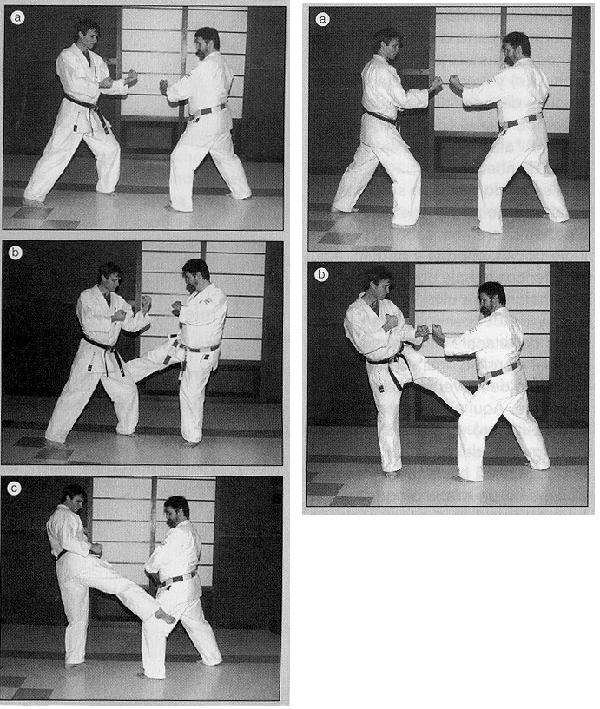
BASIC CONTACT BLOCKING DRILLS:
The next step in the process of overall body conditioning is the employing of contact as part of ones blocking drills. These basic contact blocking drills provide the practitioner with further options for forearm conditioning while at the same time working on and improving ones blocking skills, offensive and defensive movement, stancing and balance, and overall coordination and timing. These also are what one could call "self-teaching drills", as if you do not perform them correctly you get hit - and thus you learn it is better to block with the forearm than with the face, ribs or groin.
Three Contact Blocking Drills are demonstrated by the author. Initially the students learn and practice the drills separately. Start out slowly and again progress with power and speed as the skills of the training partners improve.
The first drill works off a single lunge punch by one partner which is blocked by two inside (uchi uke) blocks and then cleared by a downward (gedan barai) block as the "defender" steps in to become the "attacker" and the drill repeats itself.
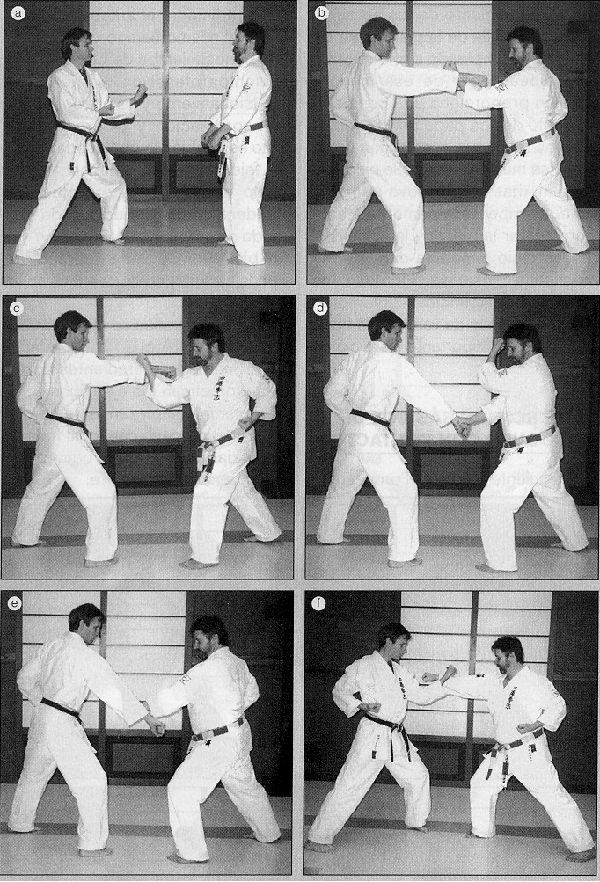
The second drill focuses on a punching attack involving three different targets - head, chest and groin (jodan, chudan & gedan). Here the defender works their upward (age uke), inside (uchi uke) and downward (gedan barai) blocks before "attacking " in their turn.
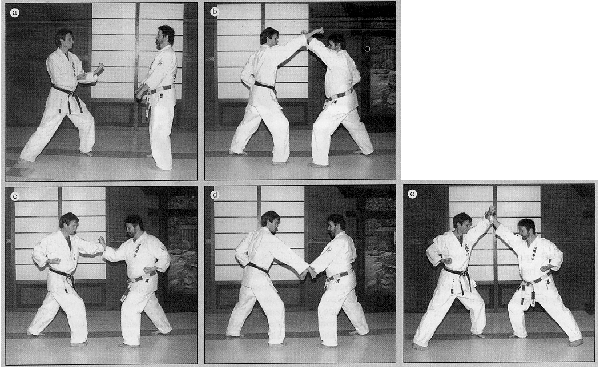
In the final drill, the concept of shifting to the outside of an attack is presented. Here the attacker punches to the face (jodan) and then to the low body (gedan)of the defender. The defender will be shifting to the outside and using only one arm to block both punch attacks (age uke & gedan barai).
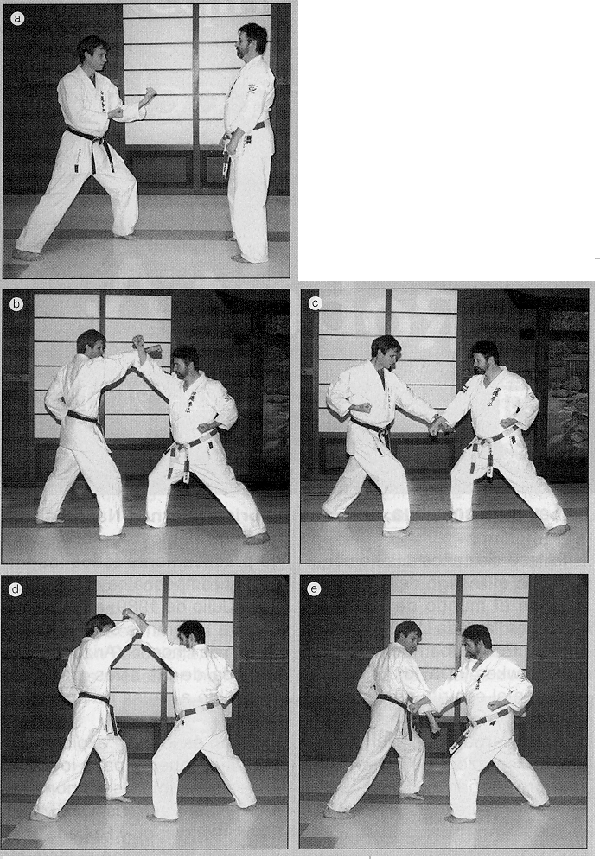
At such time when the training partners are comfortable with the three separate drills, the next step in the exercise is to perform then in series. Here is where it gets enjoyable as ones timing becomes critical.
Contact blocking drills such as those presented in this article are a common sight in many Okinawan dojos. It is truly a sight to behold to see seasoned practitioners moving in a blocking frenzy with power and focus. There is nothing sacred about the design of the drills, and variations on the theme can be found within each traditional system of Okinawan Karate. The key is that this type of partner training is something that is all too often neglected in many of the sport oriented studios of today. Conditioning our bodies through strength development exercises and contact drills is just part of the overall process to turn our bodies into our weapons and insure to our best efforts our survival.
Back To Virtual Dojo Archives
Back To Main Home Page





